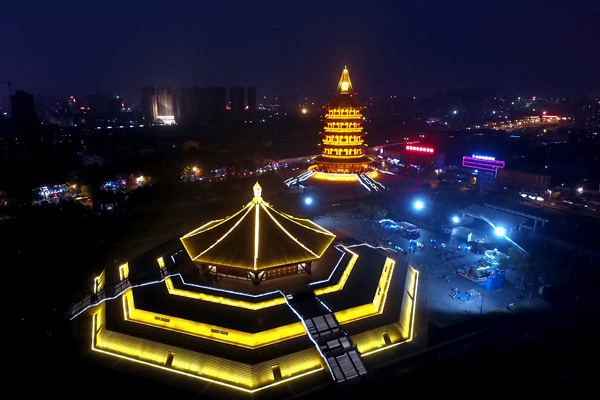
The reconstruction of the Heavenly Hall and the Hall of Enlightenment is part of Luoyang's efforts to protect the city's Tang Dynasty (618-907) relics.
The museum will include technology such as 3-D and virtual reality to reproduce ancient scenes, Zhao says.
As one of the four great ancient capitals of China, along with Xi'an, Beijing and Nanjing, Luoyang has ambitions to attract more local and international recognition.
The city was at its peak during the Tang Dynasty (618-907), when imperial China's only female ruler, Wu Zetian, moved the capital there from Chang'an, as Xi'an was then known, during her reign (690-705).
Most of Luoyang's ancient architecture has been destroyed by wars and the progress of modern construction. But the local government is investing billions to restore the grandeur of what is believed to have been the world's most populous city during the Tang Dynasty.
The city government has allocated some 47 square kilometers of land in the city center, where cultural relics were found, for a plan to restore the architecture of the Sui (581-618) and Tang dynasties, says Li Ya, Party secretary of Luoyang.
A national-level cultural relics park, including a lavish reconstructed palace and pagoda built on ancient foundations, opened to the public in 2015. The imperial garden known as Jiuzhouchi is being reconstructed in one corner of the park.
Luoyang has a grand plan to restore architecture along the ancient axis line, including ramparts, gates, bridges and 103 residential complexes where renowned politicians and poets once lived.
The re-created Tang-style architecture acts as a "protective shed" in archaeological terms, built above the original foundations to avoid damage to relics.
At the same time, the buildings serve as tourist facilities, says Wang Ge, from the municipal cultural heritage bureau.
Heritage protection is often in conflict with city development, especially as the relics area occupies a quarter of the city center. It is no easy job to maintain balance as Luoyang strives to become one of Henan's economic engines amid rapid urbanization.
"City planning and construction are intertwined with cultural relic protection. If we can handle them well, it will be a win-win situation," says Li.
As early as the 1950s, when the central government planned to turn Luoyang into a major industrial base, the local government avoided building factories in the city area, instead setting up a new industrial district in the suburbs.
Currently, 42,000 residents live in the Sui and Tang cultural relics protection area.
"Some of them will be relocated and some will be allowed to stay. It depends on the threats posed to the relics," says Li.
Qian Binggen's family was one of the 800 households relocated in 2009 due to the reconstruction of the Heavenly Hall, where Empress Wu attended Buddhist rituals, and the Hall of Enlightenment, where she handled government affairs. The relocation project cost 1.35 billion yuan.
Qian's family was relocated to a residential complex 2 kilometers away. At the beginning, Qian was reluctant to move out, but now he accepts the changes.
The protection of cultural relics should also benefit local residents, says Du Jinpeng, a researcher with the CASS Institute of Archaeology.
Providing free entrance for locals or building an archaeological theme park can give something back to those who made sacrifices for the protection of the relics, he says.